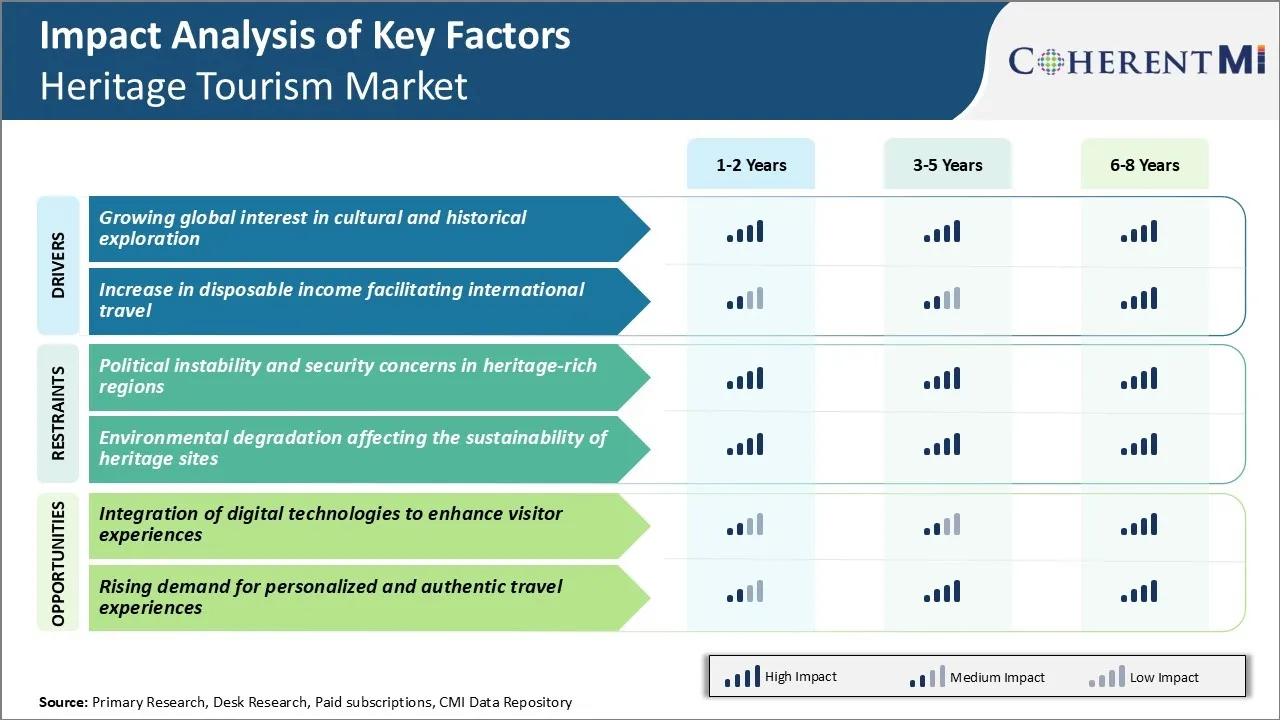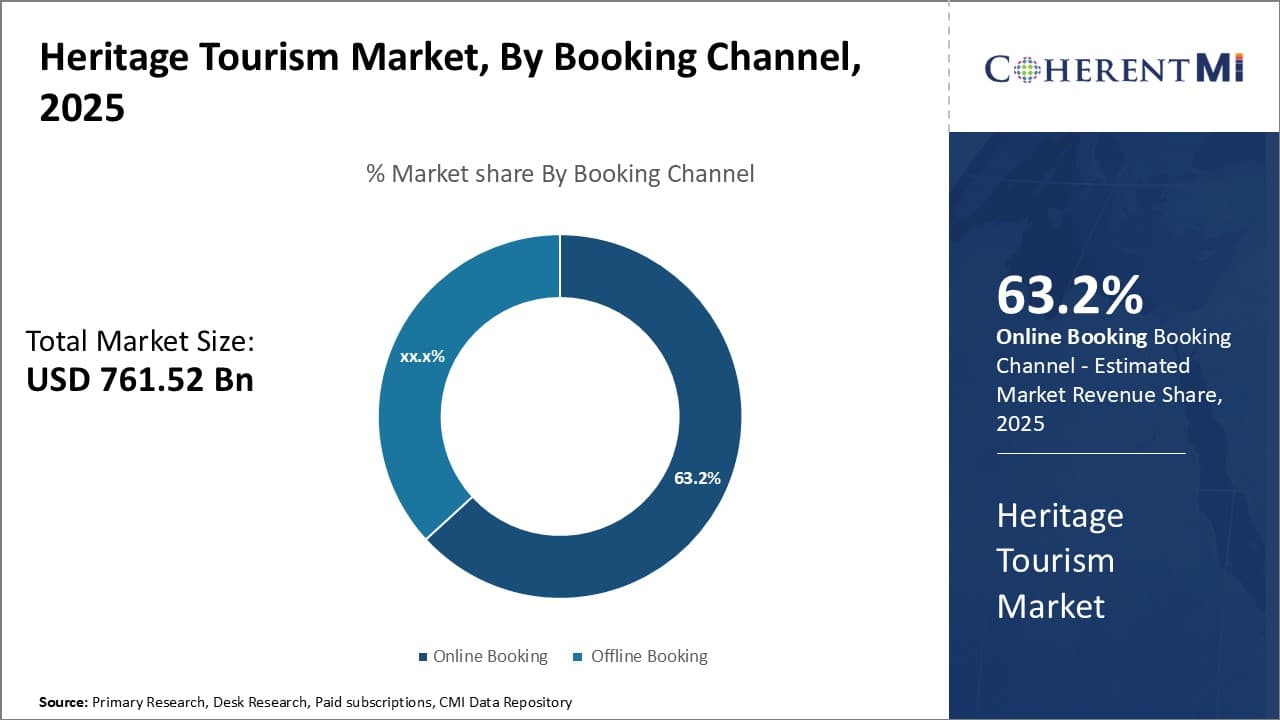

The heritage tourism market is estimated to be valued at USD 761.52 Bn in 2025 and is expected to reach USD 1255.20 Bn by 2032, growing at a compound annual growth rate (CAGR) of 7.4% from 2025 to 2032. The growing interest of travelers in exploring historical and cultural sites around the world along with various activities organized by tourism boards to promote heritage sites are fueling the revenue in this market.
Market Size in USD Bn
CAGR7.4%
| Study Period | 2025-2032 |
| Base Year of Estimation | 2024 |
| CAGR | 7.4% |
| Market Concentration | High |
| Major Players | ACE Cultural Tours Ltd., Exodus Travels Ltd., Expedia Group, Inc., BCD Travel, TUI AG and Among Others |
Market Driver - Growing Global Interest in Cultural and Historical Exploration
With each passing year people's craving to broaden their horizons and seek new experiences is increasing exponentially. This rising global interest in cultural and historical exploration has majorly boosted the heritage tourism industry.
People no longer want superficial sightseeing but prefer to understand the roots of civilizations by interacting with locals and experiencing life as it was led by earlier generations. They want to read between the lines of history and discover facets that are not found in textbooks.
Tourists wish to delve deep by attending local arts and craft workshops, cooking cultural cuisines, interacting with artisans to gain insight into the richness of intangible cultural expressions. Authentic experiences have become the buzzword with travelers yearning to feel spiritually rejuvenated by understanding how past mankind lived and what beliefs/ideologies shaped civilizations.
Countries and states recognize this pulling factor and are vigorously promoting lesser-known locales with rich cultural heritage to attract niche experiences seekers. This is expected to support heritage tourism market trends in the coming years.
Market Driver - Increase in Disposable Income Facilitating International Travel
With rising income levels and stable economic conditions prevalent worldwide, more individuals and families now have surplus money to spend on leisure and travel. Increase in disposable incomes has been a key driver propelling the growth of heritage tourism globally.
Even for the middle class, an international family vacation or couple of friends travelling abroad together is no more considered a once in a lifetime luxury. Furthermore, exploring rich cultures and heritages isn't viewed as an added expensive activity in these tours but the very essence and purpose behind them.
This phenomenon has gathered further steam in Asian countries like China and India. These are economic powerhouses with millions of new entrants every year in the income tax paying middle and upper-middle class. For them, travelling to heritage landmarks of Europe, America or other developing regions isn't just a status symbol Therefore, increased the number of heritage tourists globally is expected to emerge as the strongest driver of the heritage tourism market.
 To learn more about this report, Download Free Sample Copy
To learn more about this report, Download Free Sample Copy
Market Challenge - Political Instability and Security Concerns in Heritage-rich Regions
One of the key challenges faced by the heritage tourism market is the political instability and security concerns in heritage-rich regions across the world. Many countries that are home to UNESCO world heritage sites have witnessed rising political tensions, protests, unrest and in certain areas, an increase in terrorist activities in recent years. This has deterred international tourists from visiting such destinations due to law-and-order issues or threats to personal safety.
The heritage destinations affected include places in Middle East, North Africa, parts of Central and South Asia. The ongoing conflicts and instability have crushed the tourism industry in these countries. This has significantly hampered the growth of heritage tourism market.
The tourism boards and local authorities need to work closely with their respective governments to restore peace and stability if they wish to revive this segment. Additional security measures also need to be implemented around popular tourist sites without compromising the visitor experience.
Market Opportunity - Integration of Digital Technologies to Enhance Visitor Experiences
One of the major opportunities for the heritage tourism market is the integration of digital technologies to enhance visitor experiences. With smartphones and internet becoming widely accessible, cultural institutions, and tourist attractions can leverage digital solutions to offer immersive and engaging experiences to audiences of all ages.
Technologies such as augmented and virtual reality, 360-degree videos, mobile applications, interactive kiosks, digital touring and guidance using Bluetooth beacons can pique the interest of younger visitors in particular. These solutions present historic facts and cultural artifacts in innovative ways. They can make learning about heritage sites more fun and help combat issues like falling attention spans.
The travel industry is also embracing tools like virtual tours to give potential visitors a feel of different destinations right from their homes. If implemented correctly while preserving authenticity, digital interventions have the potential to boost visitor numbers as well as cultural appreciation.
Focus on unique experiences - Many heritage sites have started offering unique experiences centered around their cultural history and traditions. For example, many Irish castles offer medieval banquet experiences where visitors can dine and experience life from the medieval period.
Leverage technology - Advanced uses of technology are helping amplify the heritage experience. For example, some sites now offer augmented/virtual reality experiences that transport visitors back in time.
Improve storytelling - Strong narrative around the cultural and historical significance is imperative to truly engage visitors. For instance, Plimoth Plantation in the US transports visitors back to the 17th century through costumed interpreters.
Target niche interests - Instead of generic promotion, specialized heritage products are seeing more success. For example, whisky or gin trails focused on local distilleries in Scotland and England attract connoisseurs.
Partnerships and branding - Cross-promotional activities with related businesses like local restaurants, hotels, tour operators help increase visibility and occupancy. For instance, sites bearing UNESCO's heritage tag instantly attract global recognition.
 To learn more about this report, Download Free Sample Copy
Insights, By Type: Cultural Experiences Drive Demand for Cultural Heritage Tourism
To learn more about this report, Download Free Sample Copy
Insights, By Type: Cultural Experiences Drive Demand for Cultural Heritage Tourism
In terms of type, cultural heritage tourism is projected to hold 36.5% share of the heritage tourism market in 2025. This is due to travelers’ growing interest in experiencing local cultural activities and traditions. Cultural heritage sites remain top attractions that attract tourists interested in learning about history, arts, folklore and everyday life of indigenous communities.
Tourists are increasingly seeking immersive cultural experiences through active engagement with local communities rather than just passive sightseeing. Experiencing live cultural performances, artisanal workshops, local cuisines, and cultural immersion programs have become popular among tourists. The growing demand for unique, authentic, and experiential cultural activities from experiential travelers is a major driver for cultural heritage tourism market.
The recent global increase in cultural tourism has significantly contributed to the growth of cultural heritage sites as attractions. Overall, the quest for enriched cultural experiences remains a strong motivating factor that sustains the leading position of cultural heritage tourism segment.
 To learn more about this report, Download Free Sample Copy
To learn more about this report, Download Free Sample Copy
Insights, By Booking Channel: Online Convenience Boosts Popularity of Online Booking Channel
In terms of booking channel, the online booking segment is expected to hold 63.2% share of the heritage tourism market in 2025. This is due to its unparalleled convenience compared to offline channels. Travelers today heavily rely on online platforms for heritage travel planning and bookings. What appeals to them is the ease and speed of researching options and comparing prices from the comfort of their homes.
Furthermore, online booking systems allow travers to instantly reserve tickets, tours, accommodations and tailor-made packages from a variety of suppliers with just a few clicks. It provides them control and flexibility in planning their itineraries as per their preferences.
Furthermore, seamless online payment options including net banking, mobile wallets and credit cards add to the overall hassle-free online booking experience. Increasing shift towards online convenience augments the growth prospects of online booking in the heritage tourism market.
Insights, By Age Group: Experiential Mindset Drives Millennials Towards Heritage Tourism
In terms of age group, millennials contribute highest to the heritage tourism market owing to their strong experiential mindset and wanderlust spirit. Being the most travelled generation, they actively seek novel and unique experiences during their trips that provide opportunities for cultural immersion, learning and self-expression.
Social media connectivity and influence further motivates millennial travelers to visit heritage destinations for photo opportunities and content creation for networks. They commonly prefer interactive and participatory activities at heritage sites versus static sightseeing in the quest for deeper engagement.
Flexible work cultures and workplace travel also support impromptu heritage tourism plans for millennials. Their rising spending power, travel independence, and influencer status in the digital realm continue mobilizing heritage tourism’s appeal among this pivotal age cohort.
The major players operating in the heritage tourism market include ACE Cultural Tours Ltd., Exodus Travels Ltd., Expedia Group, Inc., BCD Travel, TUI AG ATG Travel, Kesari Tours Pvt. Ltd., Carlson Wagonlit Travel, Martin Randall Travel Ltd., and Travel Leaders Group.
Would you like to explore the option of buying individual sections of this report?
Gautam Mahajan is a Research Consultant with 5+ years of experience in market research and consulting. He excels in analyzing market engineering, market trends, competitive landscapes, and technological developments. He specializes in both primary and secondary research, as well as strategic consulting across diverse sectors.
Heritage Tourism Market is segmented By Type (Cultural Heritage Tourism, Historical Heritage Tourism...
Heritage Tourism Market
How big is the heritage tourism market?
The heritage tourism market is estimated to be valued at USD 761.52 Bn in 2025 and is expected to reach USD 1255.20 Bn by 2032.
What are the key factors hampering the growth of the heritage tourism market?
Political instability and security concerns in heritage-rich regions and environmental degradation affecting the sustainability of heritage sites are the major factors hampering growth of the heritage tourism market.
What are the major factors driving the heritage tourism market growth?
Growing global interest in cultural and historical exploration and increase in disposable income facilitating international travel are the major factors driving the heritage tourism market.
Which is the leading type in the heritage tourism market?
The leading type segment is cultural heritage tourism.
Which are the major players operating in the heritage tourism market?
ACE Cultural Tours Ltd., Exodus Travels Ltd., Expedia Group, Inc., BCD Travel, TUI AG ATG Travel, Kesari Tours Pvt. Ltd., Carlson Wagonlit Travel, Martin Randall Travel Ltd., and Travel Leaders Group are the major players.
What will be the CAGR of the heritage tourism market?
The CAGR of the heritage tourism market is projected to be 7.4% from 2025-2032.